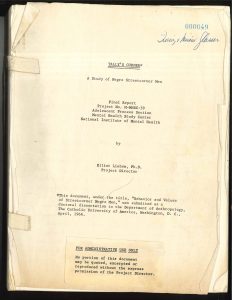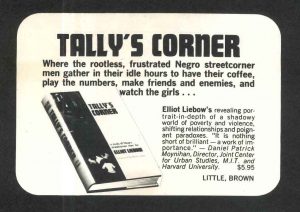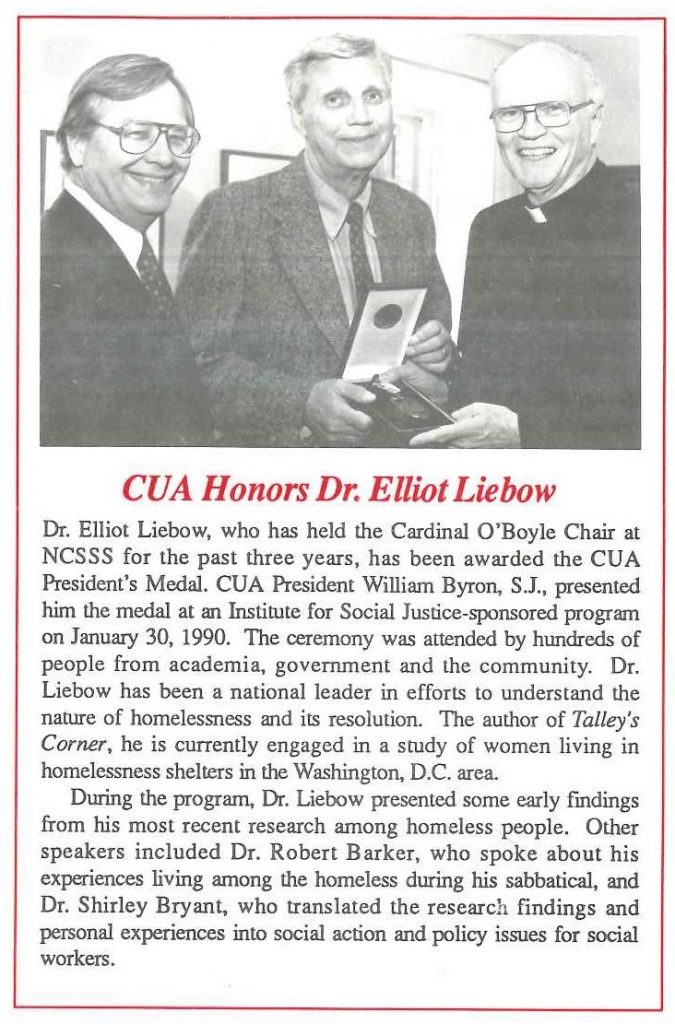
Elliot Liebow (January 4, 1925–September 4, 1994) was an anthropologist best known as the author of Tally’s Corner: A Study of Negro Streetcorner Men (1967, Little, Brown and Co.) and Tell Them Who I Am: The Lives of Homeless Women (1993, Free Press).
The two books, written more than twenty-five years apart, rather neatly bookend Liebow’s career at the National Institute of Mental Health (NIMH), over the course of which he rose to become Chief of the Center for the Study of Work and Mental Health. While Tally’s Corner—originally submitted as a Ph.D. dissertation to Catholic University’s Department of Anthropology—had grown out of research that Liebow conducted through the Health and Welfare Council of the National Capital Area on a grant from NIMH, Tell Them Who I Am punctuated the end of his career with the federal government. Liebow wound up writing Tell Them Who I Am after abruptly retiring on disability in 1984, having been diagnosed with inoperable prostate cancer and given six or eight months to live. (See Biographical Note and the preface to Tell Them Who I Am for further details.) Happily, he lived for another decade after his diagnosis.
The symmetry of Liebow’s two books is underlined by the fact that both are examples of participant observation—a traditional anthropological approach which until Tally’s Corner had rarely been applied in a Western, urban setting. “In participant observation,” Liebow explains in the preface to Tell Them Who I Am, “the researcher tries to participate as fully as possible in the life of the people being studied” (p. vii). He goes on to poke fun at himself “Doing Research (that is, hanging around)” (p. x). Despite his modesty, Liebow’s ability to get close to his subjects is the stuff of legend. In his foreword to the 2003 edition of Tally’s Corner, Charles Lemert marvels at Liebow’s informality with Sea Cat: “Liebow “flopped” on the bed. When the condoms fell out, he felt no shame either in putting them away for Sea Cat or in asking about his use of them” (p. xi). Similarly, in her review of Tell Them Who I Am—which she calls “a work full of pathos and insight”—Katherine S. Newman of Columbia University’s Department of Anthropology writes: “Virtually every social scientist in the United States was raised on a diet that included Tally’s Corner. Elliot Liebow is the exemplar of the engaged ethnographer” (see Box 49, Folder 33).

The Liebow papers provide strong evidence of his research methods in participant observer studies. That said, the overwhelming majority of his copious field notes and tape recordings must be kept closed for the time being out of consideration for the privacy of his informants. Per the terms of the gift agreement signed by Harriet Liebow (Liebow’s widow), “field notes and related material, marked ‘confidential,’ […] shall be subject to a sixty (60) year restriction from the date of creation of said notes.” The finding aid indicates which materials are open for research and which are closed (and until when).
The first time I heard Liebow’s voice, I was surprised by how deep it was. I was listening to some tape recorded life history interviews with informants for Tell Them Who I Am (see Box 50), and I couldn’t help but be charmed by his parting words to one especially deferential interviewee: “You don’t have to call anybody anything but their first names,” he assured her, “[no] Miss Anybody […] and it’s just plain Elliot.” Tape recordings like that one offer some of the most vivid pictures of Liebow to be found anywhere in the papers; unfortunately, the collection contains very few photographs of him (and what few there are are rather poor quality). Because his role as participant observer seems so unavoidably personal, I found the lack of photographs both frustrating and tantalizing. While it’s true that he gives physical descriptions of himself in both of his books—6’1” tall, 185 pounds at the time of Tally’s Corner (p. 164) and ten pounds lighter, with white hair, by the time of Tell Them Who I Am (p. x)—these cursory accounts fall far short of capturing his charisma. In an obituary that appeared in the November 1994 issue of Anthropology Newsletter, Kim Hopper, the one-time president of the National Coalition for the Homeless, recalls Liebow’s incredible capacity to disarm (see Box 49, Folder 47):
Liebow was a consummate (some would say relentless) ethnographer and teacher. Two cardinal virtues of that dual profession—an ability to listen closely and a gift for storytelling—he held in abundance. Legend (confirmed) has it he once interviewed two men he had interrupted in the process of stealing the alternator from his parked car. (They desisted; “Give the man back his bolts!,” one of them reminded the other as they took their leave.) “It’s amazing what you can learn if you just don’t get excited,” was Liebow’s comment on the episode.
Perhaps the most lingering and impressive aspect of the Liebow papers is the documentation of his so-called retirement, during which, faced with his own imminent death, he steadfastly went on telling us who they are—tossing out stereotypes of the underclasses, just as he had in Tally’s Corner.

To learn more about the Elliot Liebow Papers, please see the newly published finding aid.
